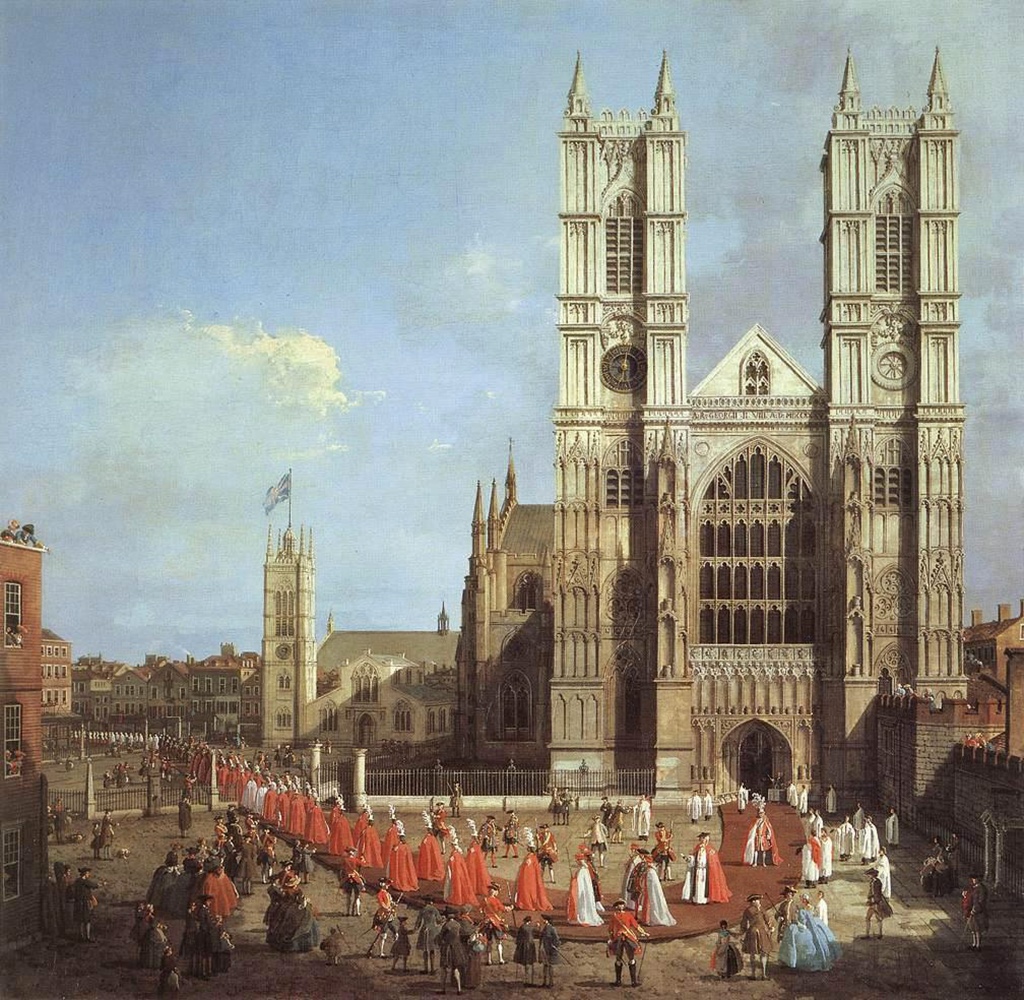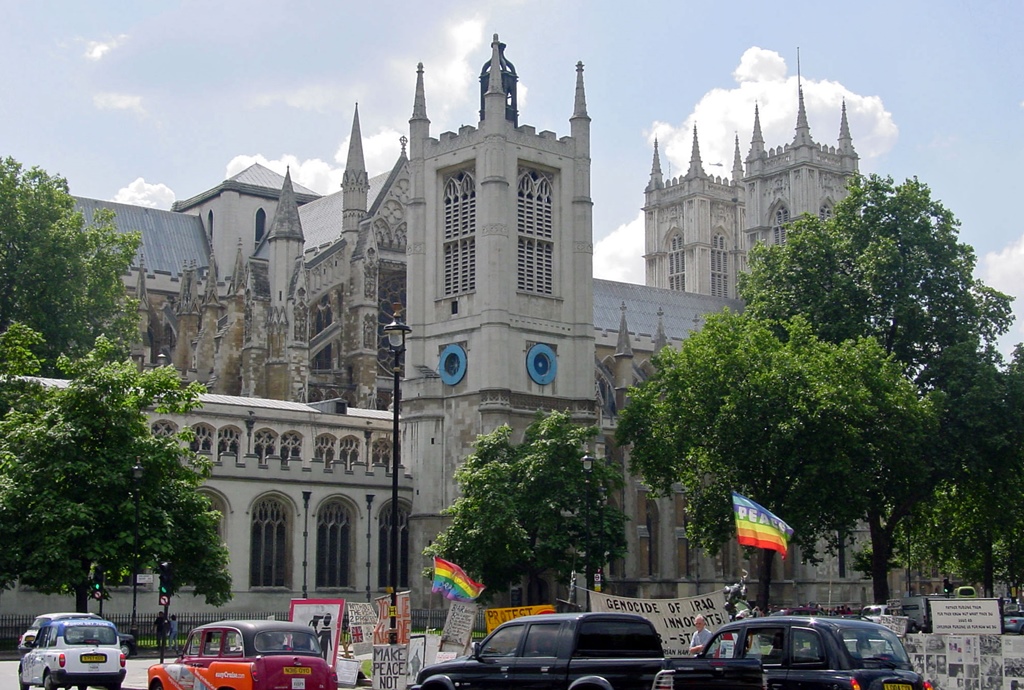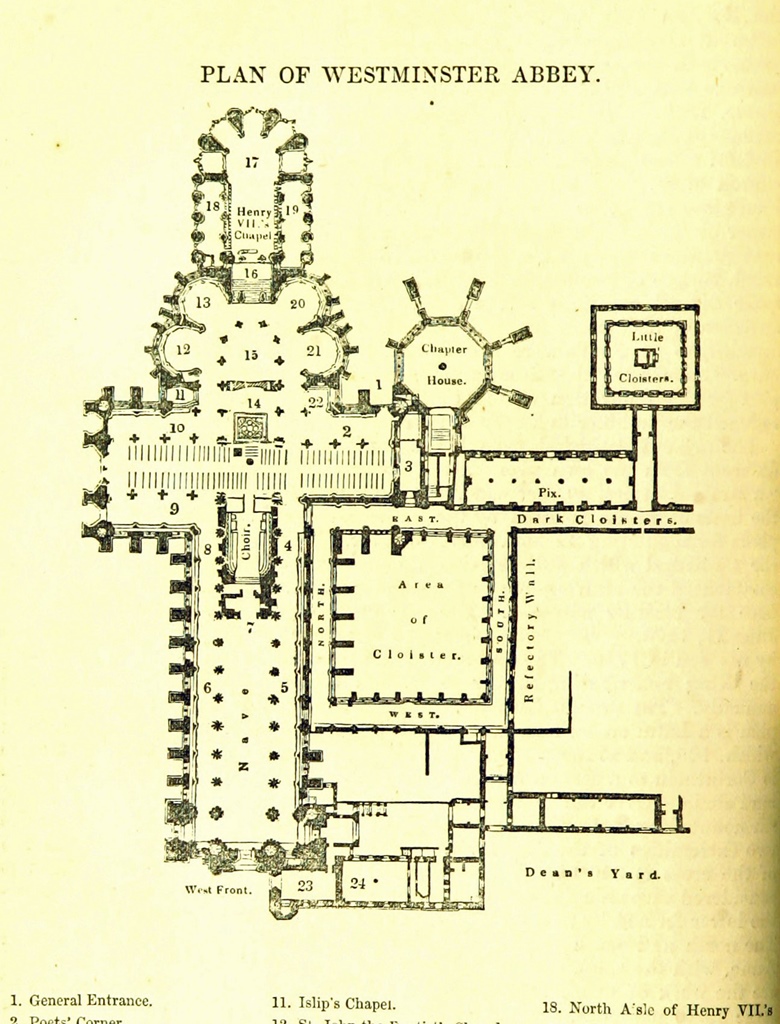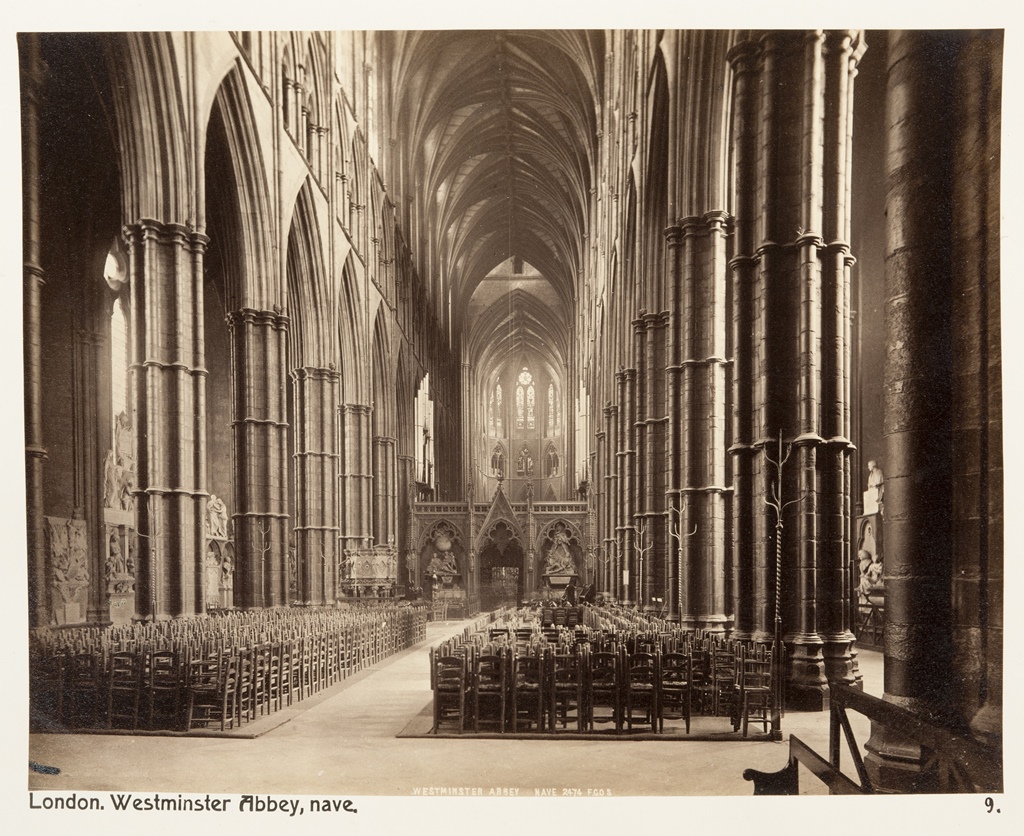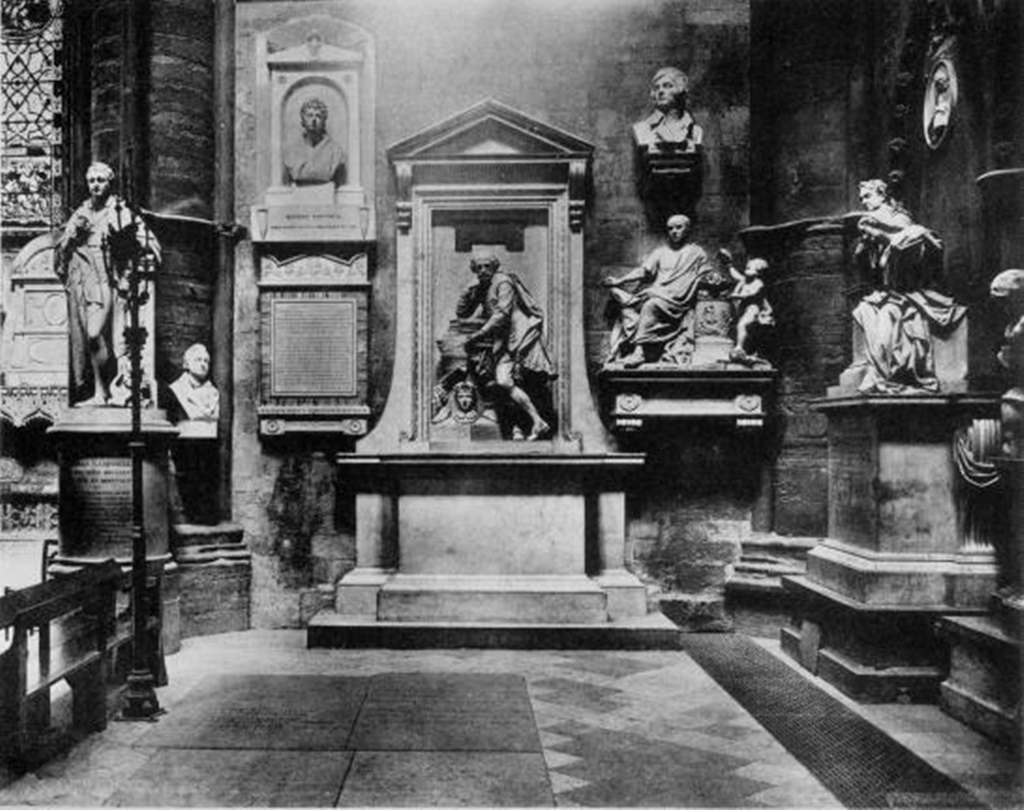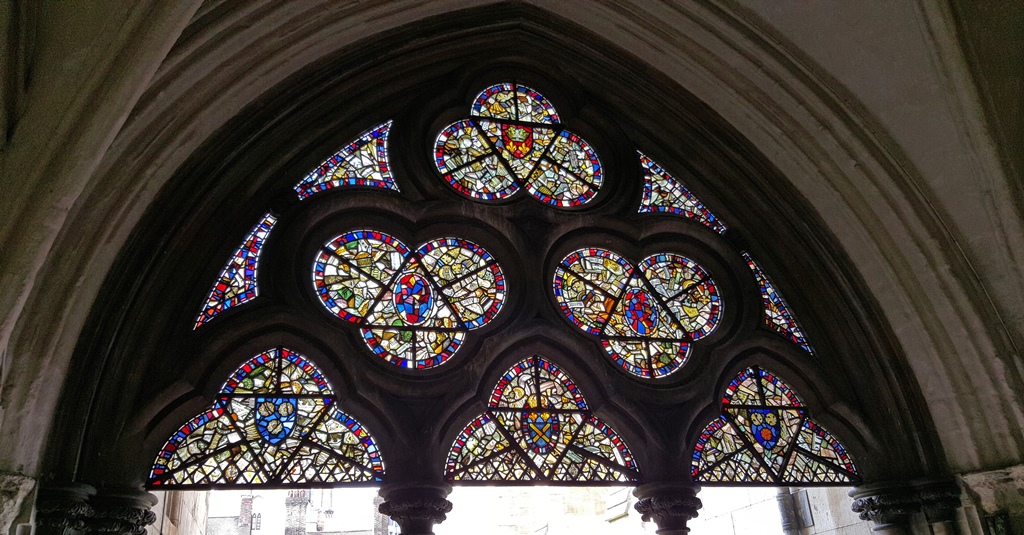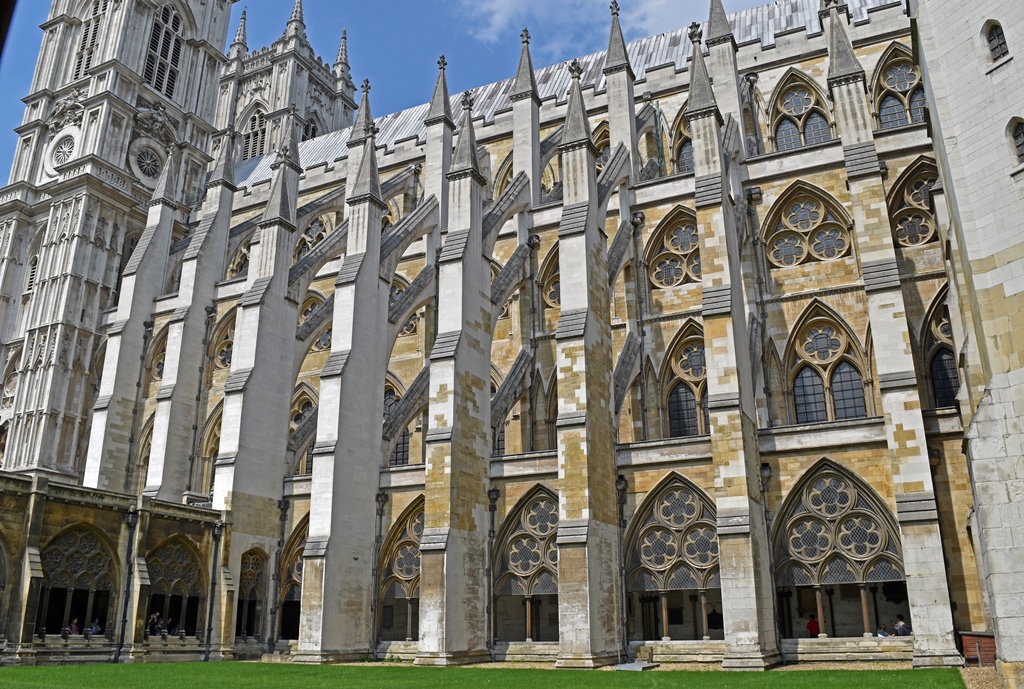Westminster Abbey in 1749 (Canaletto)
Westminster Abbey is a large church in London in the City of Westminster. Its name
came from its status as a large monastic church (or minster) to the west of the City of
London (the central part of the municipal area where the city was founded). The borough
"City of Westminster" gets its name from the church, rather than the other way around.
The church's official title is the "Collegiate Church of Saint Peter at Westminster",
and it has the special Church of England status of "Royal Peculiar", meaning it is
responsible directly to the sovereign (currently Queen Elizabeth II), rather than being
involved in the usual Church of England chain of command.
Westminster Abbey is one of the top tourist attractions in London for several reasons.
First, it's quite large (530 feet long, with twin 225-foot towers) and beautiful inside
and out. To those with any curiosity about history, the abbey is the site of every
English/British coronation going back at least to William the Conqueror, in 1066.
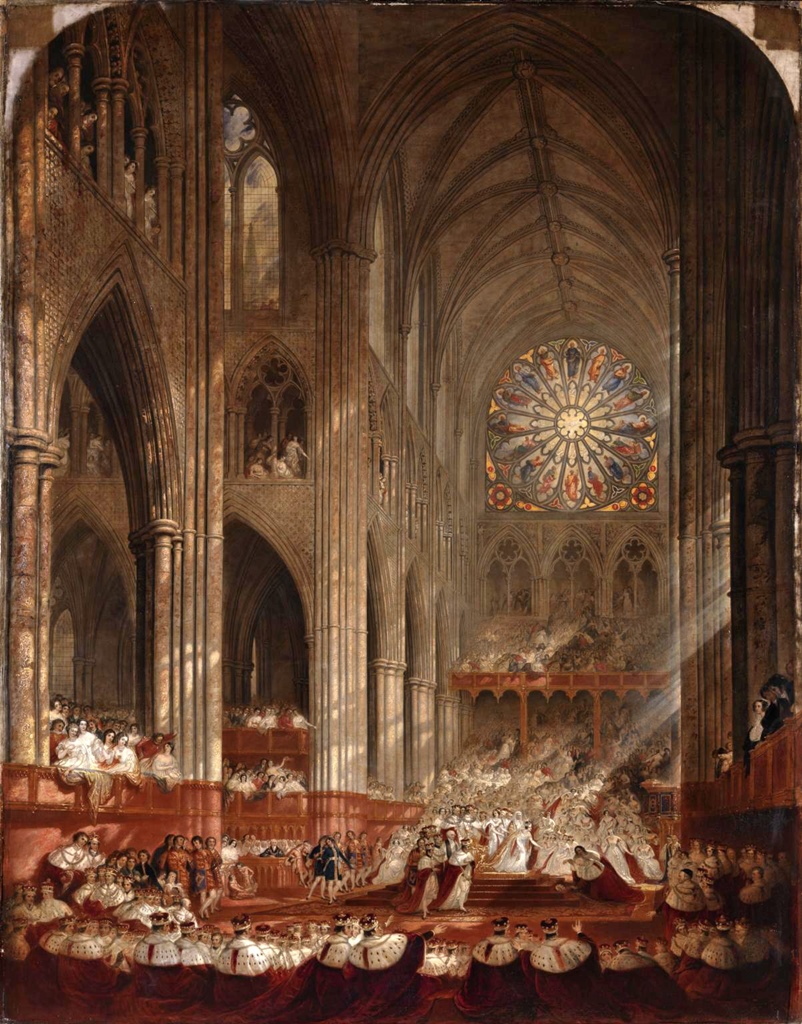
Coronation of Queen Victoria, John Martin (1839)
The abbey has also been the site of 16 royal weddings, most recently that of Prince
William and Kate Middleton in 2011 (Prince William's grandmother Queen Elizabeth was
also married here, to Prince Philip in 1947 – Her Majesty was just a princess then,
but she returned for her coronation in 1952 following the death of her father,
George VI). The abbey would also have to qualify as possibly the most prestigious
cemetery in the English-speaking world. Thousands of people, both royal and non-royal,
are buried in the abbey (not including George VI, who is buried at Windsor Castle). A
much-abridged list of the most well-known buried here would include Mary I,
Elizabeth I, Mary, Queen of Scots, Neville Chamberlain, Charles Darwin, Stephen
Hawking, Isaac Newton, William Pitt, William Gladstone, Robert Browning, Geoffrey
Chaucer, Charles Dickens, George Frederick Handel, Thomas Hardy, Rudyard Kipling,
Laurence Olivier, Alfred Tennyson, Henry Purcell, Ralph Vaughan Williams and Anne of
Cleves. There are also innumerable monuments to well-known Brits who are buried
elsewhere (e.g. Jane Austen, the Brontë sisters, Lord Byron, Winston Churchill,
Princess Diana, Benjamin Disraeli, Francis Drake, C.S. Lewis, Lewis Carroll, Henry
Wadsworth Longfellow, William Shakespeare, Oscar Wilde).
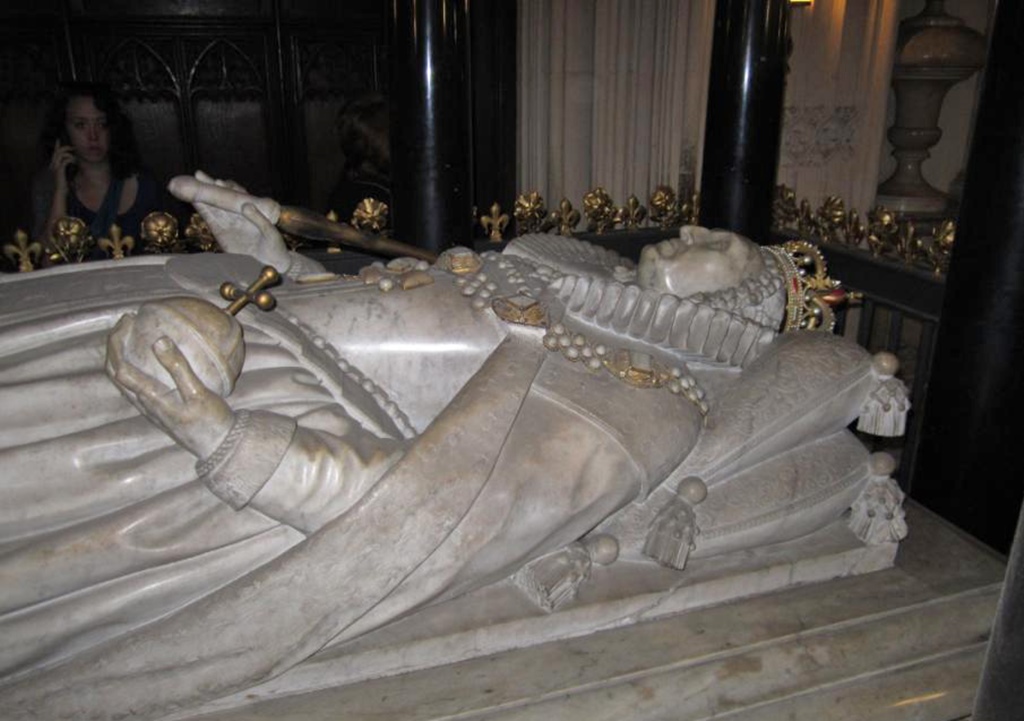
Tomb of Elizabeth I

Grave of Charles Dickens
Oliver Cromwell, who ruled as Lord Protector during the tumultuous Interregnum
in the 17th Century, was also buried in the abbey after his death in 1658, but in
1661, after the restoration of the monarchy, his body was dug up, hanged and beheaded
for regicide (Charles I had been beheaded during the revolution that began the
Interregnum) before being disposed of elsewhere. His head remained on public display
on a spike in Westminster until the 1680s, after which it fell off during a storm and
apparently was passed around between collectors and museum owners until finally being
buried in Cambridge in 1960.
The original abbey at the Westminster site was established in the 960s or 970s as a
community of Benedictine monks. During the following century, King Edward the
Confessor had the abbey rebuilt, with construction of the church being completed
around 1060.
St. Edward the Confessor (1003? - 1066)
The building wasn't consecrated until late in 1065, and Edward died a week later, on
January 5 of 1066. At this time the throne passed to his brother-in-law Harold
Godwinson, who was probably the first king to be crowned in the new church
(documentation doesn't exist). If you've been paying attention, you've probably
deduced that Harold's reign was a short one, as 1066 was also the year of William
the Conqueror. William was a Norman duke who felt he had a claim to the throne
after Edward's death (Edward was William's first cousin once removed, and William
claimed that Edward had promised the throne to him). William showed up in England
with an army and defeated (and killed) Harold at the Battle of Hastings on October
14. William was crowned in the abbey on Christmas Day as William I, this being
the first documented coronation in the building.
Around 1245, King Henry III began a rebuild of the church as a burial site. He
created a shrine for Edward the Confessor and had his remains brought there for
burial. And of course he had himself buried there as well (after his death, of
course) in 1272. The rebuild wasn't finished at this time, and nobody seemed too
interested in resuming it after Henry's death, so the church kept its old
Romanesque nave until Richard II had it demolished and rebuilt in Gothic style late in the 14th
Century. Early in the 16th Century, Henry VII added a chapel dedicated to the
Blessed Virgin Mary (now called the Henry VII Chapel or the "Lady Chapel"), which
brought the church to the length it has today.
Things became a little dicey for the abbey later in the 16th Century after Henry
VIII separated the country from the Catholic church in 1534, making himself head
of the Church of England (and the spiritual leader of all of his subjects).
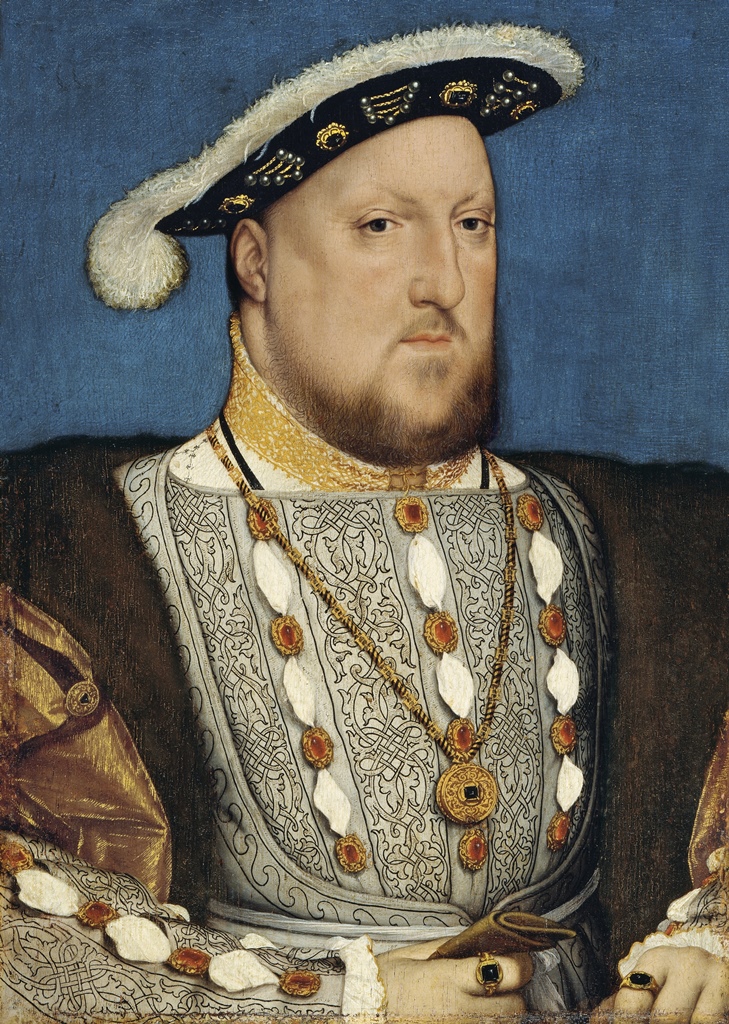
Henry VIII, Hans Holbein the Younger (ca. 1537)
Under Henry's orders, most abbeys and monasteries in England were dissolved and
forced to forfeit their assets to the crown (of all places). But Westminster Abbey
was spared this fate, as Henry declared it to be a cathedral of the newly-formed
Westminster diocese. It was not allowed to function as an abbey, however, and the
Benedictines were expelled. Henry's daughter (by Catherine of Aragon) and eventual
queen (following half-brother Edward VI, who succeeded Henry), Mary I, remained a
Catholic on ascending to the throne in 1553 and tried to restore the country to Catholicism,
in the process bringing the Benedictines back to Westminster. But despite Mary's
best efforts (she had 280 religious dissenters burned at the stake, earning her the
nickname "Bloody Mary"), she was unable to fully return the country to its former
faith during her brief five-year reign, which ended in 1558. At this time she was
succeeded by Henry's other daughter (by Anne Boleyn), Elizabeth I. Elizabeth was
a staunch Protestant and sent the Benedictines packing again. It was Elizabeth who
assigned the abbey the "Royal Peculiar" status it has retained through the present
day.
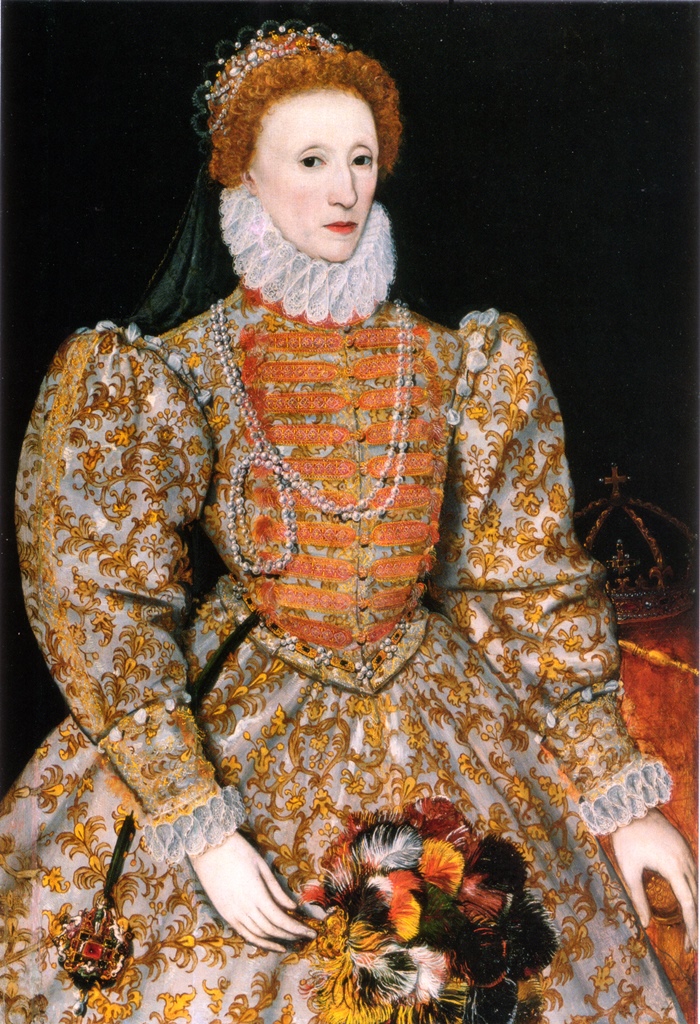
Elizabeth I (ca. 1575)
Following our adventure with the London Eye, we set off to visit the Royal
Peculiar. This involved a crossing of the Thames via the Westminster Bridge, at
the end of which we encountered Big Ben and the Houses of Parliament.
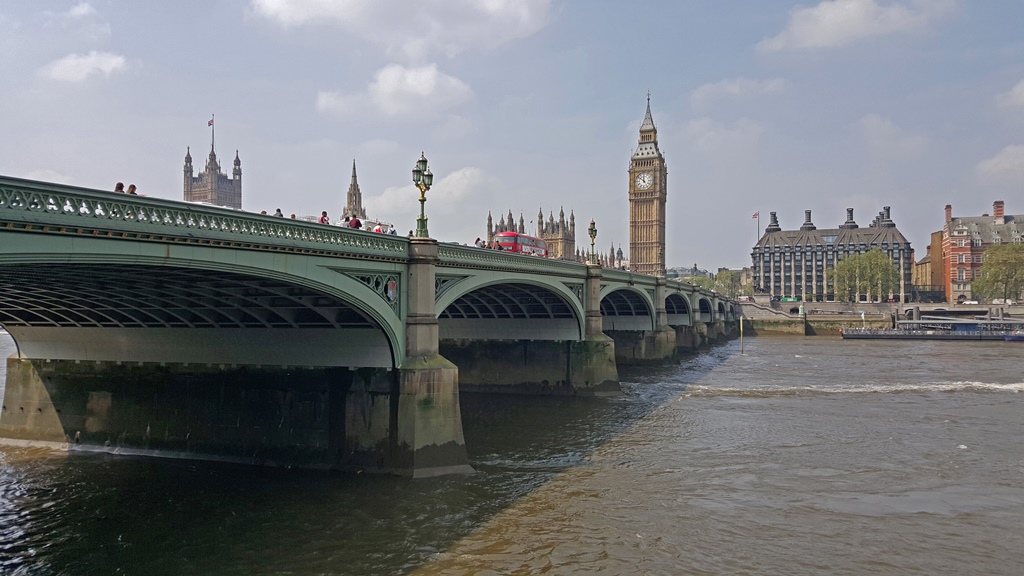
Westminster Bridge and Big Ben

Bob with Houses of Parliament
The official name for the building in which the Parliament of the United Kingdom
meets is the Palace of Westminster. The present neo-Gothic building was constructed
between 1840 and 1876, replacing a medieval building which was destroyed by fire in
1834. The building is instantly recognizable by anyone with even a passing
familiarity with England or the United Kingdom, especially when viewed along with
its clock tower. "Big Ben" is technically the name of the largest bell inside the
tower, but the name is commonly used to refer to the entire tower structure. The
tower's official name is the Elizabeth Tower, a name assigned in 2012 as a
celebration of the Diamond Jubilee of Elizabeth II.

Parliament with Statue of Richard I
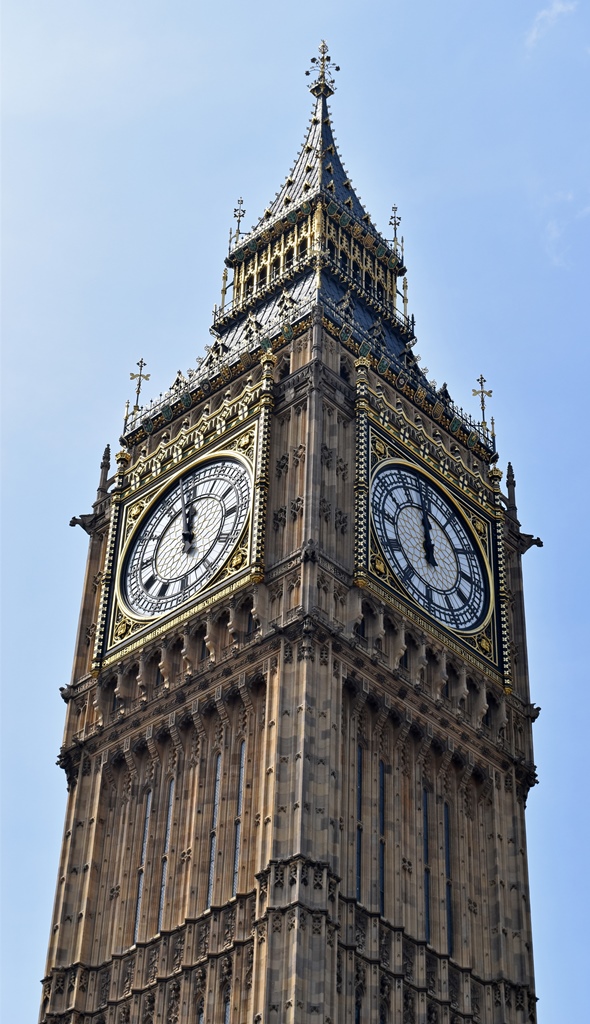
The Elizabeth Tower
Across the street from Parliament is a more-or-less permanent encampment of
protestors (to be expected these days), and beyond the protestors is a smallish
church called the Church of St. Margaret,
originally founded in the 12th Century as a parish church. The church was
rebuilt from 1486 to 1523 at the instigation of Henry VII, around the same time
he was elongating Westminster Abbey. Until 1972, St. Margaret's was the
Anglican parish church of the House of Commons, but in 1972 it was made a part
of the Westminster Abbey complex. St. Margaret's is somewhat overwhelmed by
the gigantic church just to its south, but it does have a certain amount of
history of its own. Weddings of some historical figures have taken place here,
including those of Samuel Pepys, John Milton, Winston Churchill, Harold
Macmillan and Lord Louis Mountbatten. It's not the massive tomb that its
neighbor is, but it is the final resting place of Sir Walter Raleigh, among
others.
St. Margaret's Church
Beyond St. Margaret's, of course, is the abbey itself. The church has an
east-west orientation, and the main entrance is on its north side, through
the north transept.
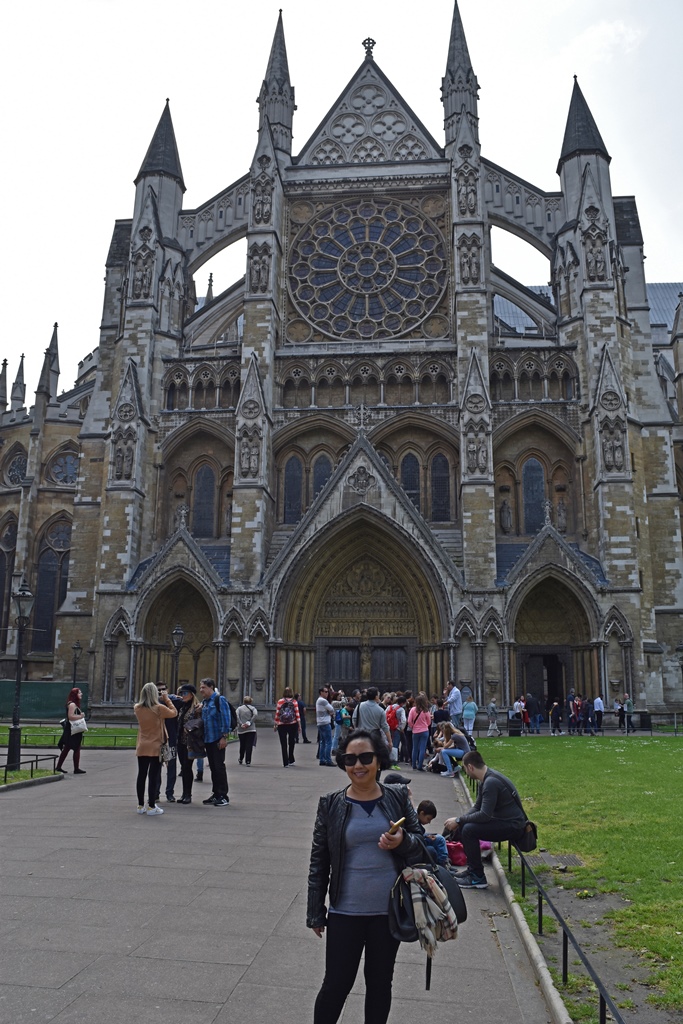
Nella and Westminster Abbey
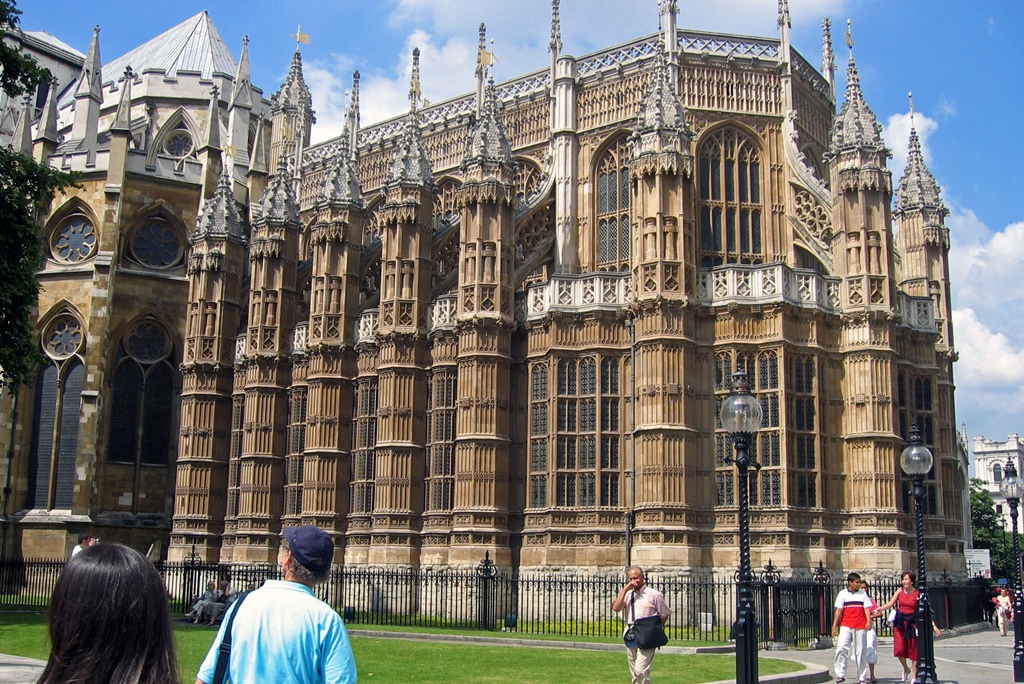
Outside of the Lady Chapel
Bob and Great North Door
Tickets can be purchased at the entrance, though they are also available online
for a slight discount. They're a little pricey for church tickets (currently
more than 20 pounds per adult), but this isn't just any church. Also at the
entrance are signs prohibiting photography inside the church, a restriction
about which they appear to be serious. The church interior pictures on this
page came from Wikimedia Commons, and were taken by people other than us.
Abbey Layout (1858)
Entering at the north transept (the left side of the church on the layout
above) puts you roughly in the middle of the church. To the right is the choir
(spelled "quire" in the documentation for some reason) and the nave as rebuilt
by Richard II in the 14th Century. Toward the western end of the nave there is a
chapel devoted to St. George, and in this chapel there is an old wooden chair.
This is the Coronation Chair, on which all English/British monarchs have been
crowned since the 14th Century. A built-in compartment under the seat is designed
to hold the Stone of Scone, a block of red sandstone on which monarchs of Scotland
are crowned. The Stone of Scone is currently kept at Edinburgh Castle, but it
will be fetched back to London when it's time to crown the next monarch.
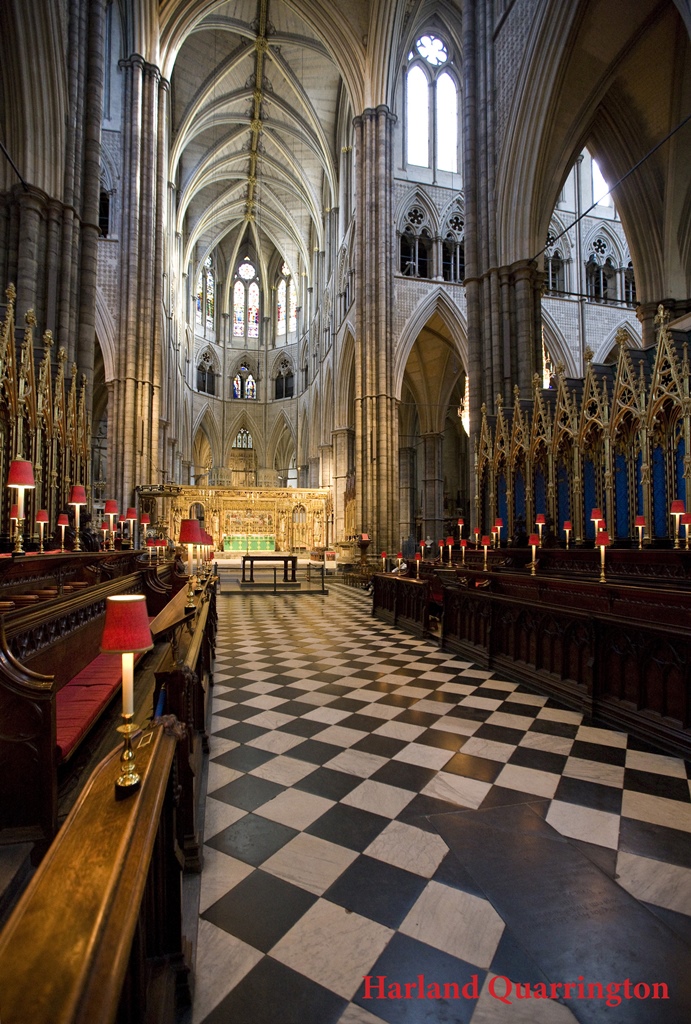
View from Quire Toward Lady Chapel
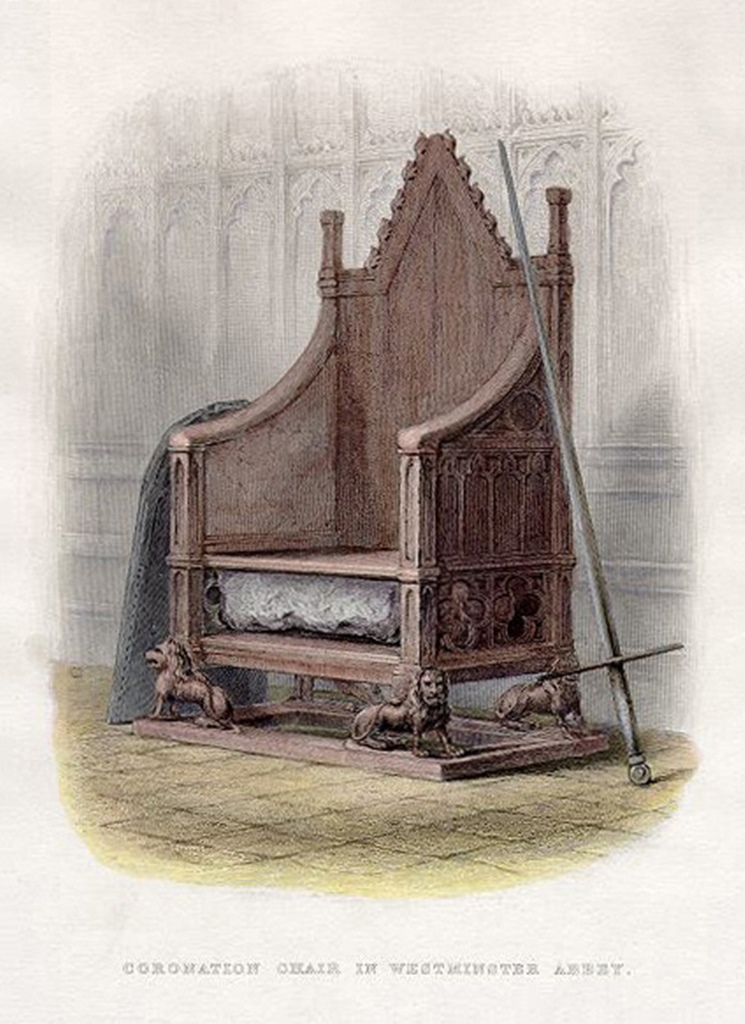
Coronation Chair with Stone of Scone (1859)
The other end of the church is mostly occupied by the Lady Chapel, with some
smaller side chapels. Some royal tombs can be found in the side chapels,
including those of Elizabeth I and Mary I. Mary, Queen of Scots is also found
here. In the middle of the nave there is a shrine to Edward the Confessor.
Shrine of Edward the Confessor and Lady Chapel (1886)
The south transept is largely devoted to a space known as Poets' Corner. This
is where the memorials and burial places of most of the literary figures can
be found.
Poets' Corner
There is more to Westminster Abbey than the church, and a doorway near the
south transept takes you into this area. It also takes you out of the area
(the church) where photography is forbidden, so stand by for more pictures.
First up is the cloister area, where cloisters surround a grassy courtyard.

East Cloister
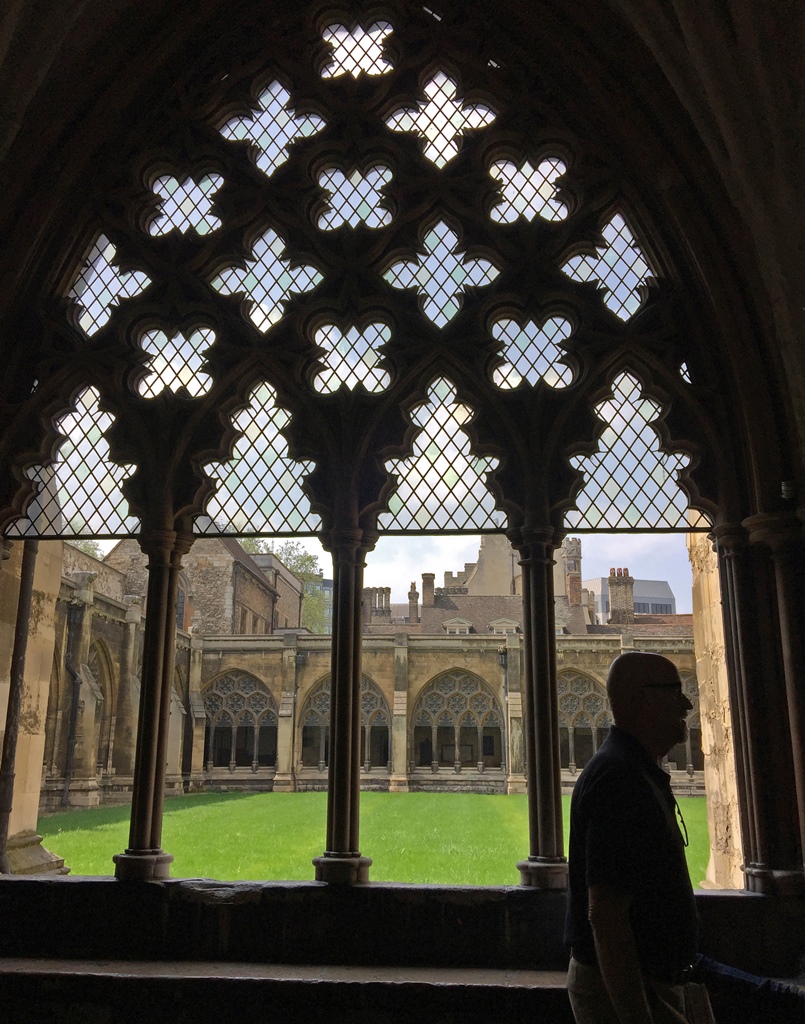
Courtyard from East Cloister
Stained Glass in East Cloister
From the eastern cloister there is access to a large, octagonal structure
called the Chapter House. The Chapter House dates back to the 13th Century,
and was originally used as a meeting place for the Benedictine monks. There
is a single support column in the middle of the structure, and it's
surrounded by stained-glass windows and the remnants of 14th Century
religious paintings. During our visit, the Chapter House was being guarded
by an orange pussycat.
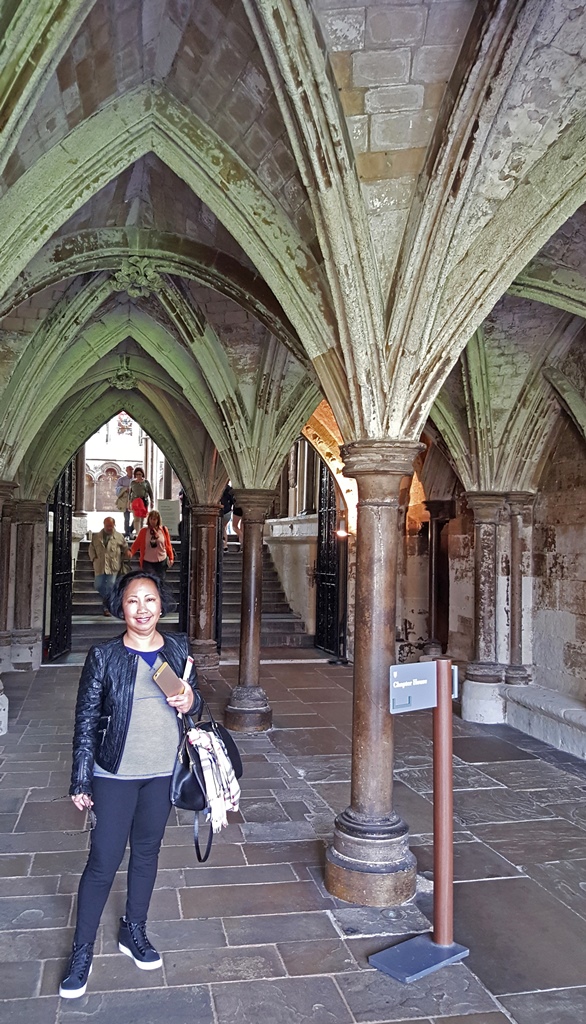
Nella and Entry to Chapter House
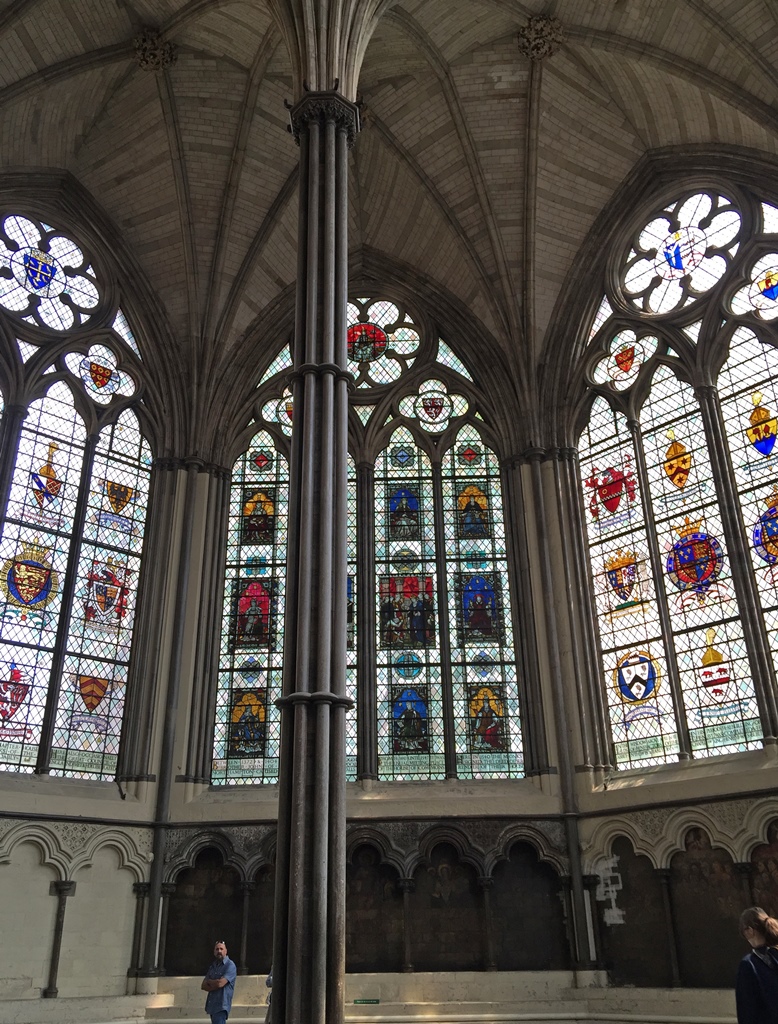
Chapter House

Chapter House
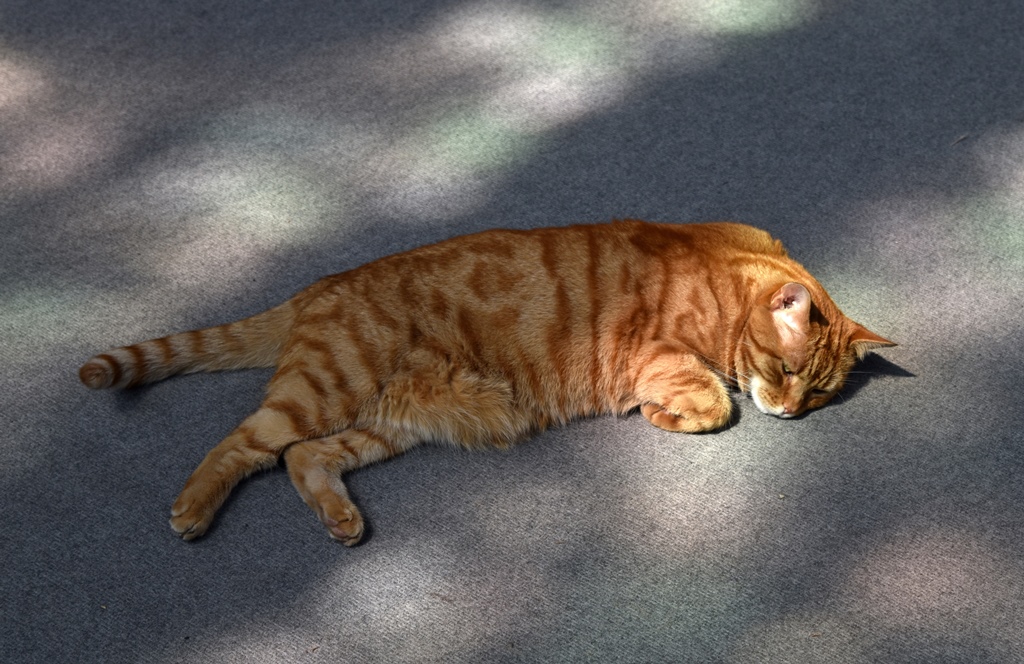
Cat Guarding Chapter House
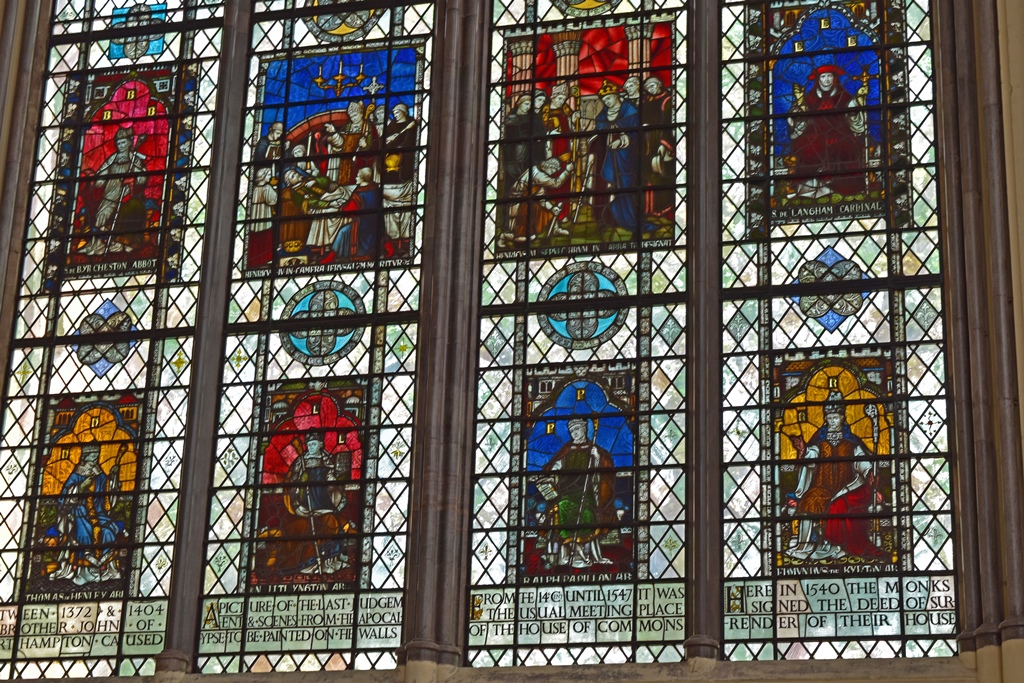
Chapter House Window
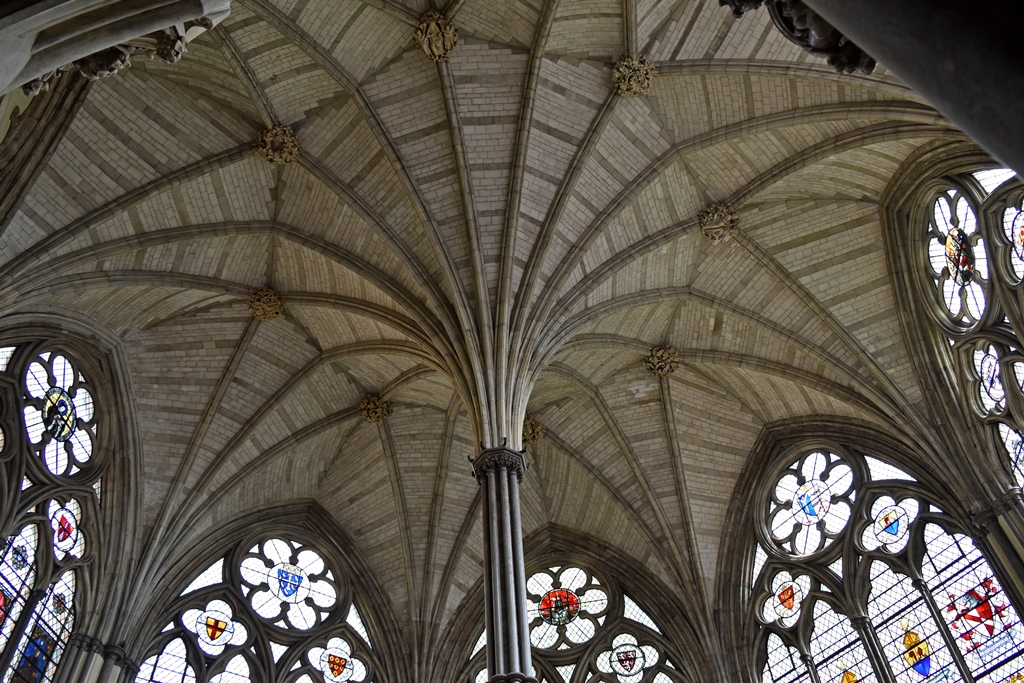
Chapter House Vaulting
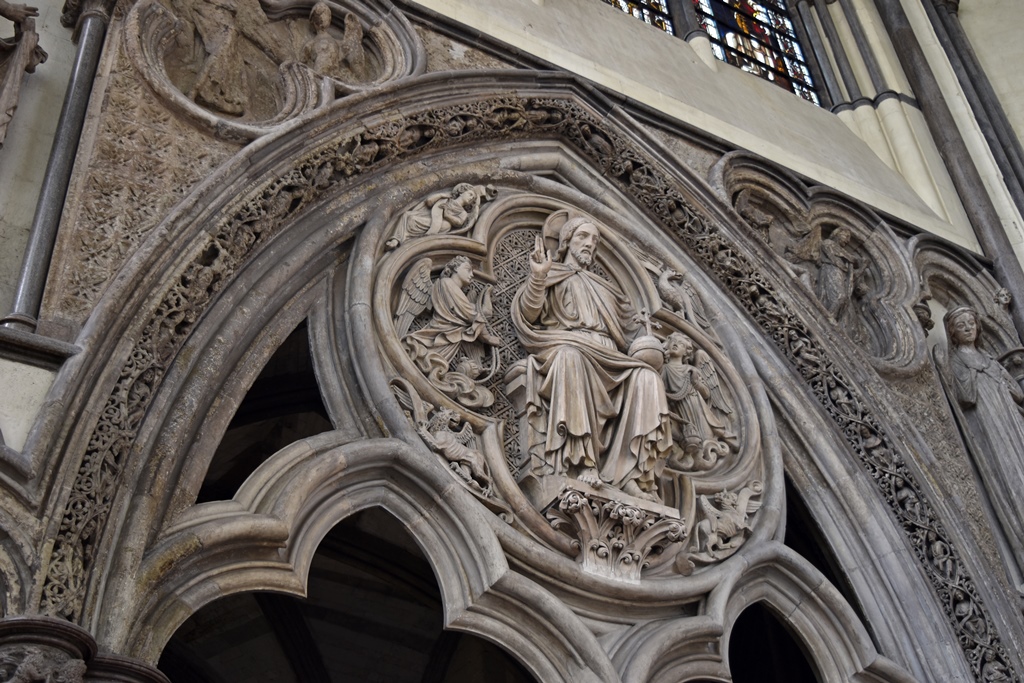
Chapter House Sculpture
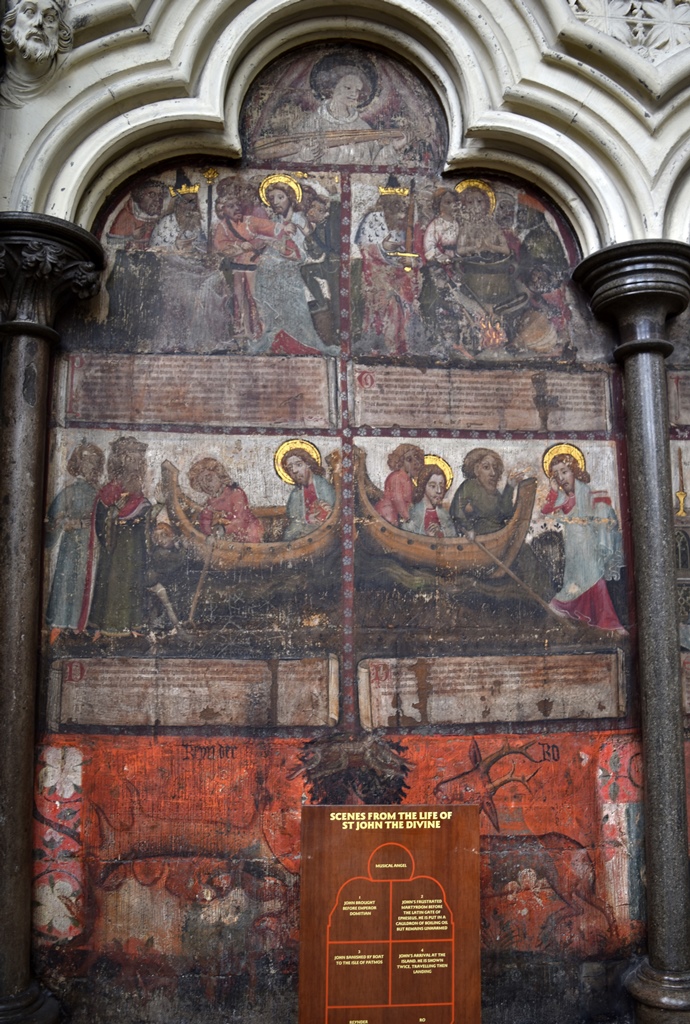
Scenes from the Life of St. John the Divine (ca. 1395)
Farther down the eastern cloister there is a doorway leading to the Pyx Chamber.
The Pyx Chamber is now a primitive-looking chapel, but it was once used as secure
storage for the Pyx and related objects. An annual ceremony called the Trial of the
Pyx has long been performed in which a jury examines newly-minted coins to make sure
they conform to established metallurgical standards. The ceremony has taken place
in different locations, but in all cases the coins to be tested are presented in a
chest called the Pyx (once kept in the Pyx Chamber). These days the ceremony
is pretty much a formality, but it's still done regularly.
Pyx Chamber
From the Pyx Chamber, we made our way over to the West Cloister, where we had some
different things to look at.

West Cloister and Courtyard
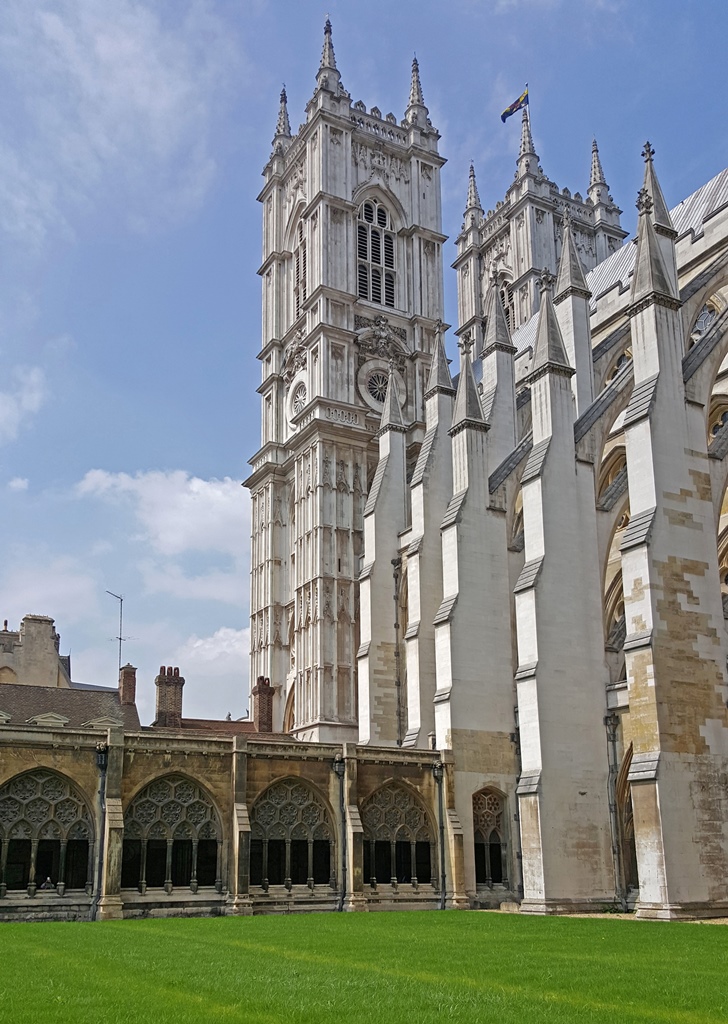
West Cloister and Bell Towers
Abbey and Bell Towers
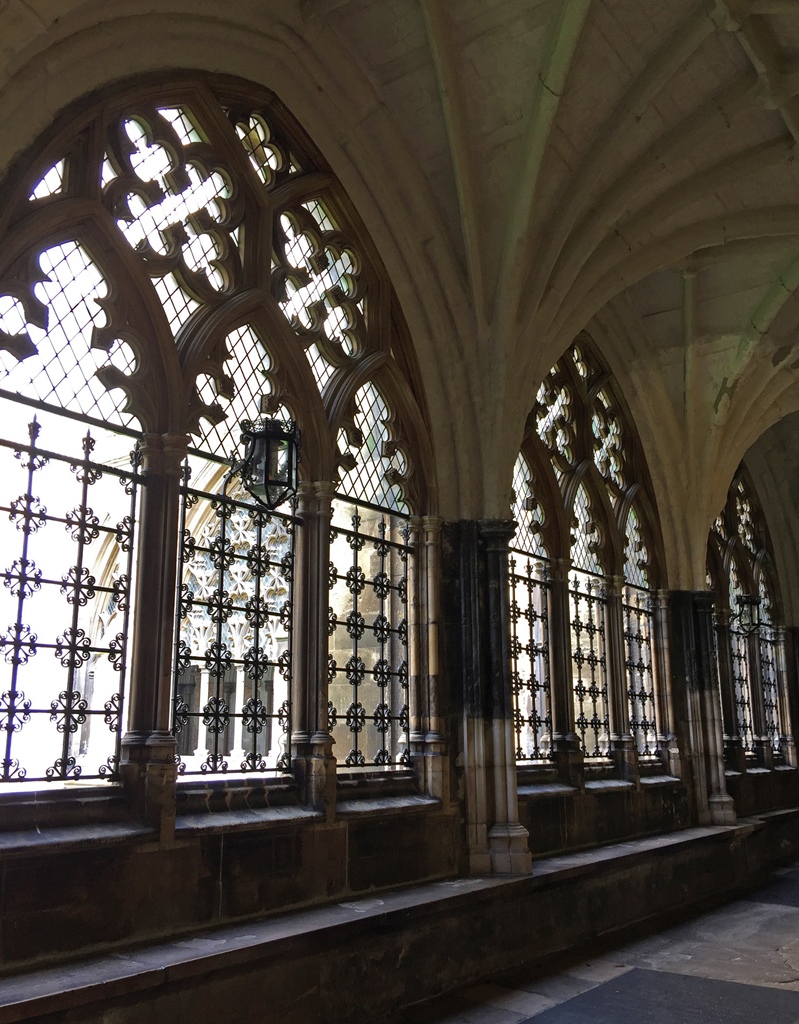
In the West Cloister
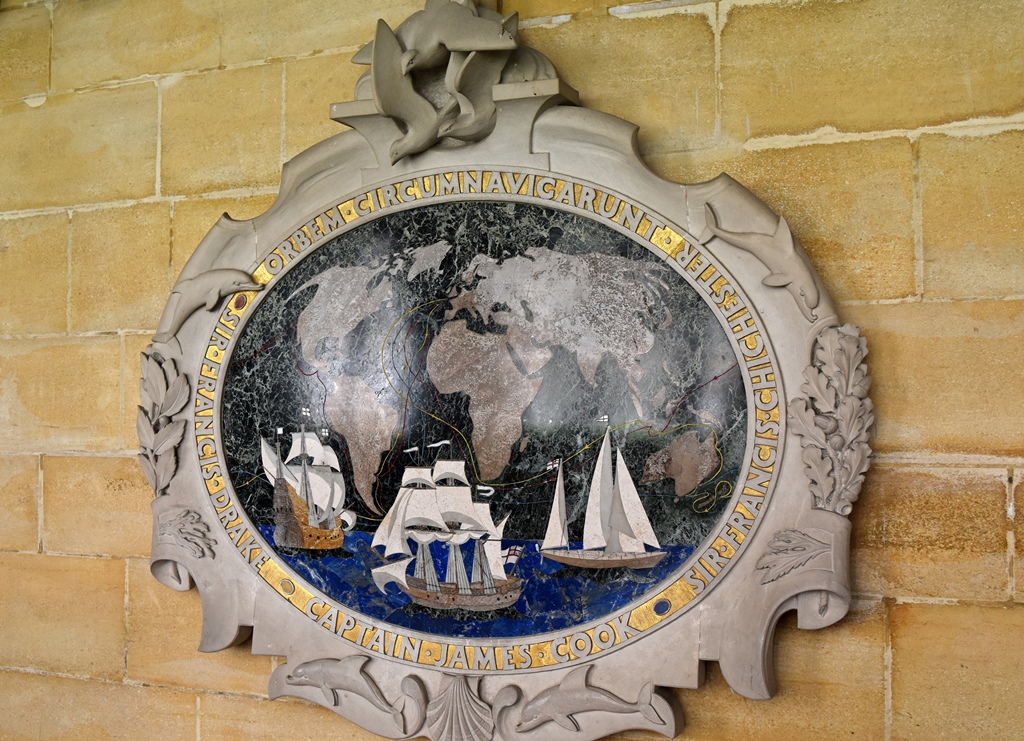
Circumnavigation Medallion, West Cloister
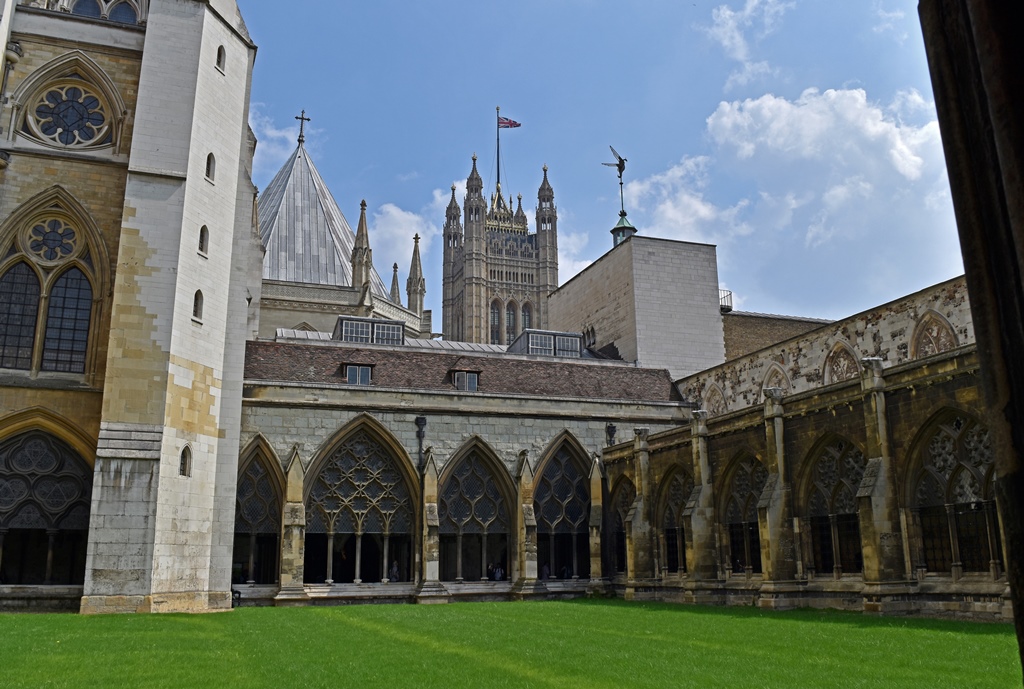
Cloisters and Victoria Tower

Victoria Tower
Eventually we exited the abbey and found ourselves outside the church's western
doorway, at the base of the nave. This gave us a nice look at the church's
twin towers (added between 1722 and 1745) and western façade. Above the
doorway are statues of ten 20th Century martyrs. Not all of the martyrs are
British – for example, martyr number 5 from the left is Martin Luther King, Jr.
Western Façade
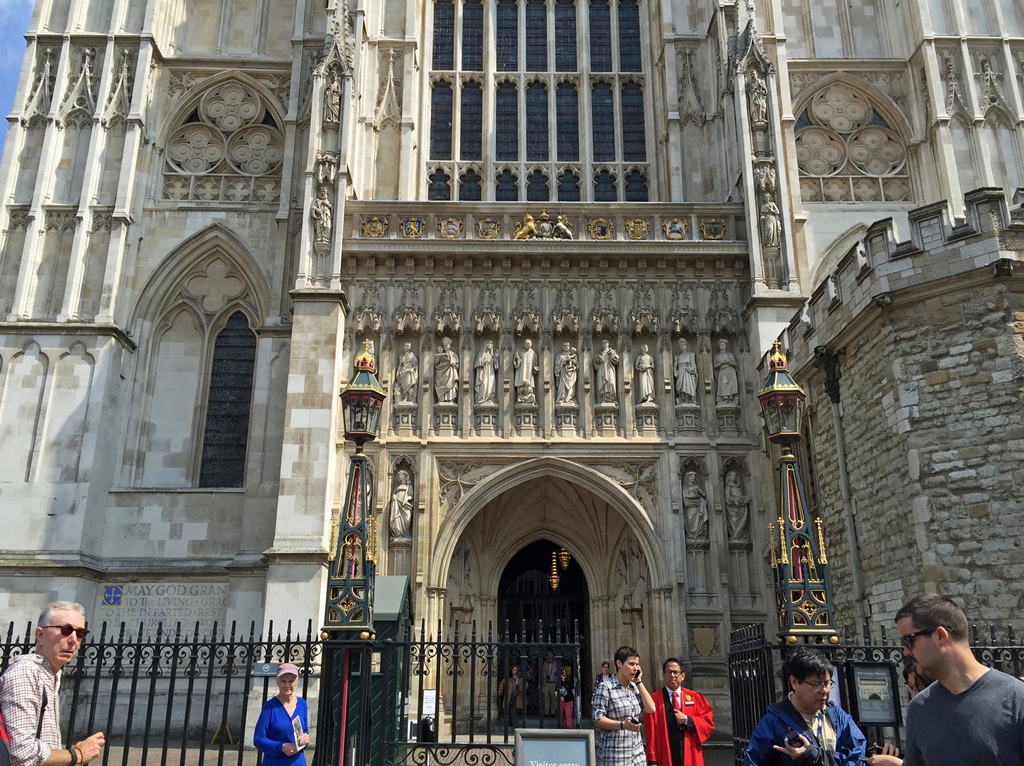
Great West Door

20th Century Martyrs Above Great West Door
We looked around a little in the square in from of the western doorway and then
headed back toward the London Eye. At the time we bought our London Eye tickets,
we also bought tickets to a guided cruise along the Thames, and our boat was to
depart from a floating dock in front of the Ferris wheel. Continue on to the
next page to see how this worked out.
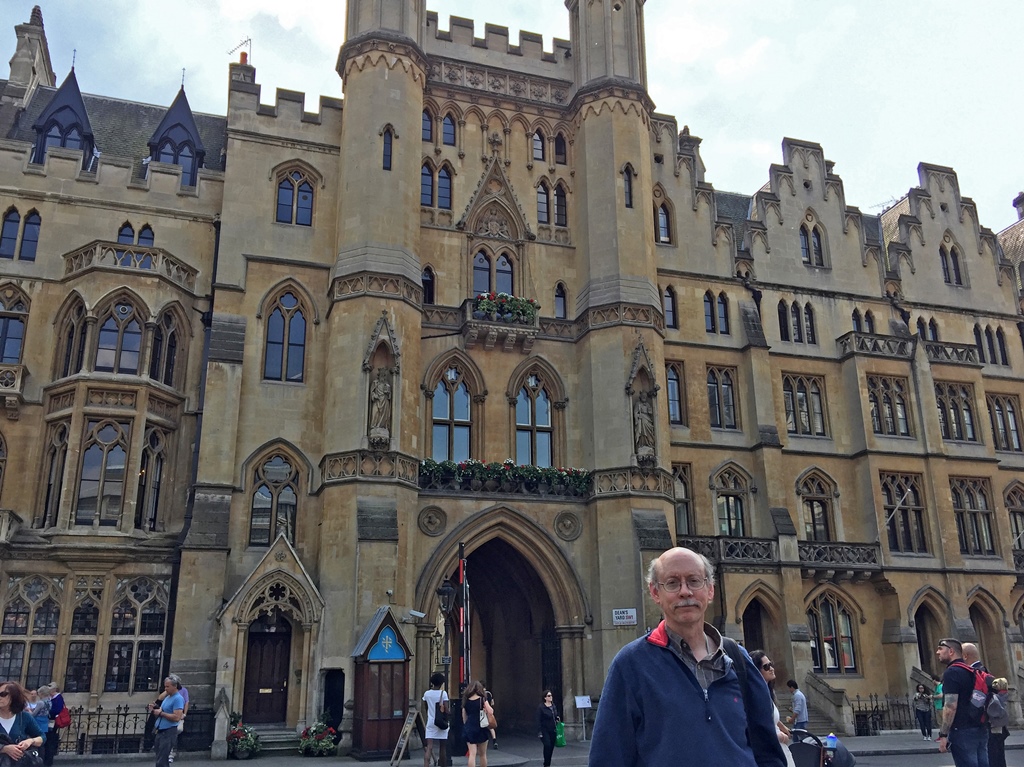
Bob and The Sanctuary
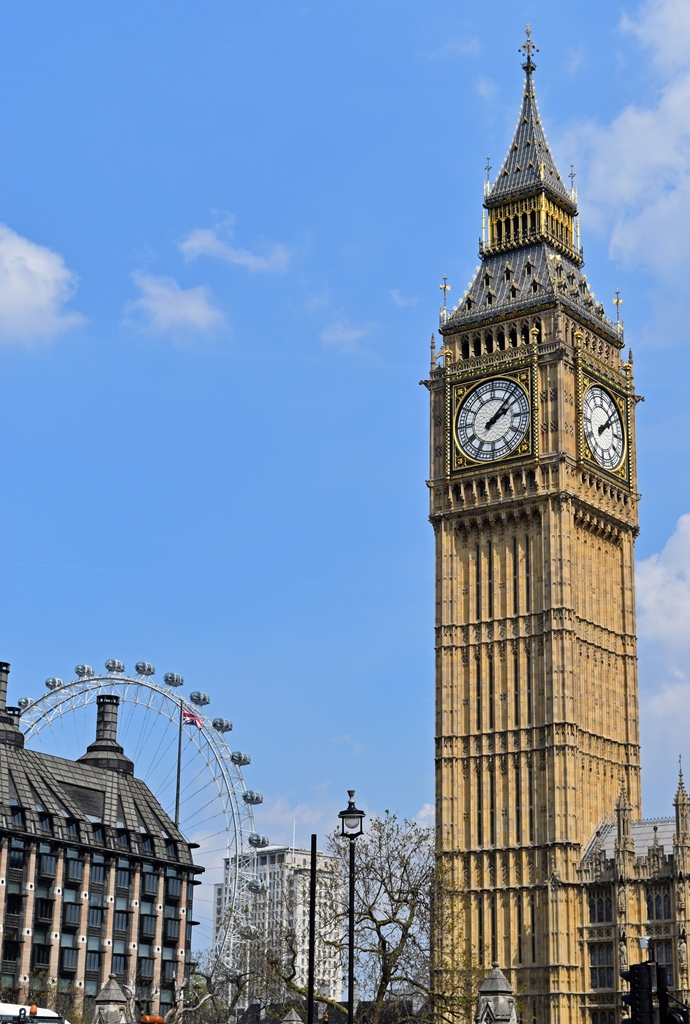
Big Ben and London Eye

